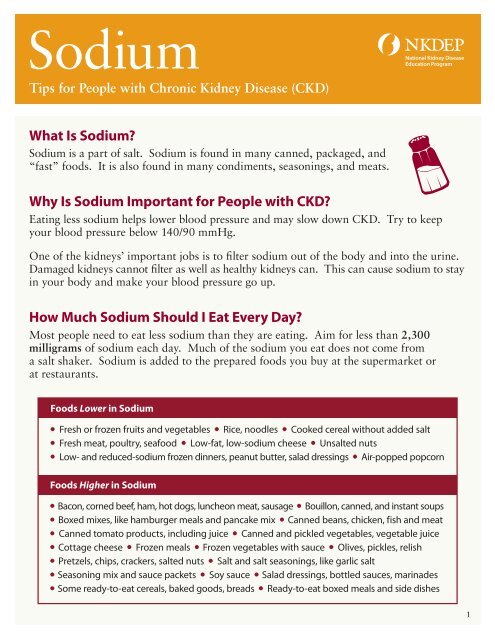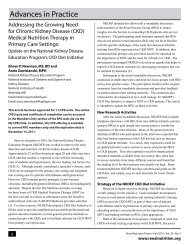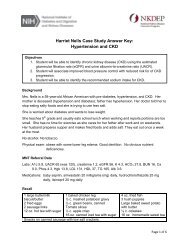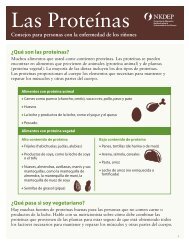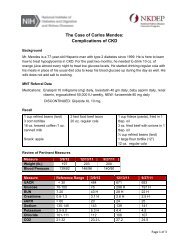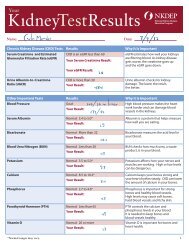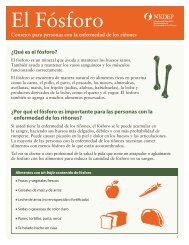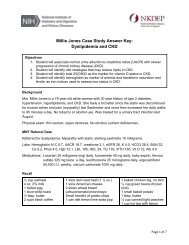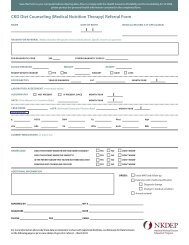Sodium: Nutrition Tips for People with CKD - National Kidney ...
Sodium: Nutrition Tips for People with CKD - National Kidney ...
Sodium: Nutrition Tips for People with CKD - National Kidney ...
- No tags were found...
You also want an ePaper? Increase the reach of your titles
YUMPU automatically turns print PDFs into web optimized ePapers that Google loves.
<strong>Sodium</strong><strong>Tips</strong> <strong>for</strong> <strong>People</strong> <strong>with</strong> Chronic <strong>Kidney</strong> Disease (<strong>CKD</strong>)<strong>National</strong> <strong>Kidney</strong> DiseaseEducation ProgramWhat Is <strong>Sodium</strong>?<strong>Sodium</strong> is a part of salt. <strong>Sodium</strong> is found in many canned, packaged, and“fast” foods. It is also found in many condiments, seasonings, and meats.Why Is <strong>Sodium</strong> Important <strong>for</strong> <strong>People</strong> <strong>with</strong> <strong>CKD</strong>?Eating less sodium helps lower blood pressure and may slow down <strong>CKD</strong>. Try to keepyour blood pressure below 140/90 mmHg.One of the kidneys’ important jobs is to filter sodium out of the body and into the urine.Damaged kidneys cannot filter as well as healthy kidneys can. This can cause sodium to stayin your body and make your blood pressure go up.How Much <strong>Sodium</strong> Should I Eat Every Day?Most people need to eat less sodium than they are eating. Aim <strong>for</strong> less than 2,300milligrams of sodium each day. Much of the sodium you eat does not come froma salt shaker. <strong>Sodium</strong> is added to the prepared foods you buy at the supermarket orat restaurants.Foods Lower in <strong>Sodium</strong>l Fresh or frozen fruits and vegetables l Rice, noodles l Cooked cereal <strong>with</strong>out added saltl Fresh meat, poultry, seafood l Low-fat, low-sodium cheese l Unsalted nutsl Low- and reduced-sodium frozen dinners, peanut butter, salad dressings l Air-popped popcornFoods Higher in <strong>Sodium</strong>l Bacon, corned beef, ham, hot dogs, luncheon meat, sausage l Bouillon, canned, and instant soupsl Boxed mixes, like hamburger meals and pancake mix l Canned beans, chicken, fish and meatl Canned tomato products, including juice l Canned and pickled vegetables, vegetable juicel Cottage cheese l Frozen meals l Frozen vegetables <strong>with</strong> sauce l Olives, pickles, relishl Pretzels, chips, crackers, salted nuts l Salt and salt seasonings, like garlic saltl Seasoning mix and sauce packets l Soy sauce l Salad dressings, bottled sauces, marinadesl Some ready-to-eat cereals, baked goods, breads l Ready-to-eat boxed meals and side dishes1
<strong>Sodium</strong>How Do I Lower the <strong>Sodium</strong> in My Diet?■ Buy fresh foods more often.■ Cook foods from scratch, instead of eating prepared foods,“fast” foods, frozen dinners, and canned foods that are higher in sodium.■ Use spices, herbs, and sodium-free seasonings in place of salt. Check <strong>with</strong> yourhealthcare provider about using salt substitutes.■ Rinse canned vegetables, beans, meats, and fish <strong>with</strong> water to remove extra sodium.Always read the <strong>Nutrition</strong> Facts label to compare foods.Choose foods <strong>with</strong> the lowest Percent Daily Value (%DV)<strong>for</strong> sodium. The %DV lets you see if a food is high or lowin sodium. 5% or less is low and 20% or more is high.■ Check the label on fresh meats and poultry.<strong>Sodium</strong> additives can be used tomake meat last longer.■ Look <strong>for</strong> foods labeled: sodium free, salt free,very low sodium, low sodium, reduced or lesssodium, light in sodium, no salt added, unsalted,and lightly salted.<strong>Nutrition</strong> FactsServing Size: 1 cup (228g)Servings Per Container: 2Amount Per ServingCalories: 260 Calories from Fat: 120% Daily Value*Total Fat 13g 20 %Saturated Fat 5g 25 %Trans Fat 2gCholesterol 30mg 10 %<strong>Sodium</strong> 660mg 28 %Total Carbohydrate 31g 10%Dietary Fiber 0g 0 %Sugars 5gProtein 5gVitamin A 4%Vitamin C 2%Calcium 15% • Iron 4%* Percent Daily Values are based on a 2,000calorie diet.There may bemore than oneserving in thepackage, so besure to checkserving size.This numbertells you the% DV <strong>for</strong>sodium inone serving.Check the Ingredient Label <strong>for</strong> Added <strong>Sodium</strong>l Salt (sodium chloride) l Monosodium glutamate or MSG l Baking soda (sodium bicarbonate)l Baking powder l <strong>Sodium</strong> nitrate l <strong>Sodium</strong> sulfite l <strong>Sodium</strong> phosphate l <strong>Sodium</strong> alginatel <strong>Sodium</strong> benzoate l <strong>Sodium</strong> hydroxide l <strong>Sodium</strong> propionateFor more in<strong>for</strong>mation, visit www.nkdep.nih.gov or call 1-866-4 KIDNEY (1-866-454-3639).The <strong>National</strong> <strong>Kidney</strong> Disease Education Program(NKDEP) encourages people to get tested <strong>for</strong> kidneydisease and educates those <strong>with</strong> kidney disease andtheir providers about treatments that can help delayor prevent kidney failure. NKDEP is a program ofthe <strong>National</strong> Institutes of Health.NIH Publication No. 14-7407 • Revised June 20142


